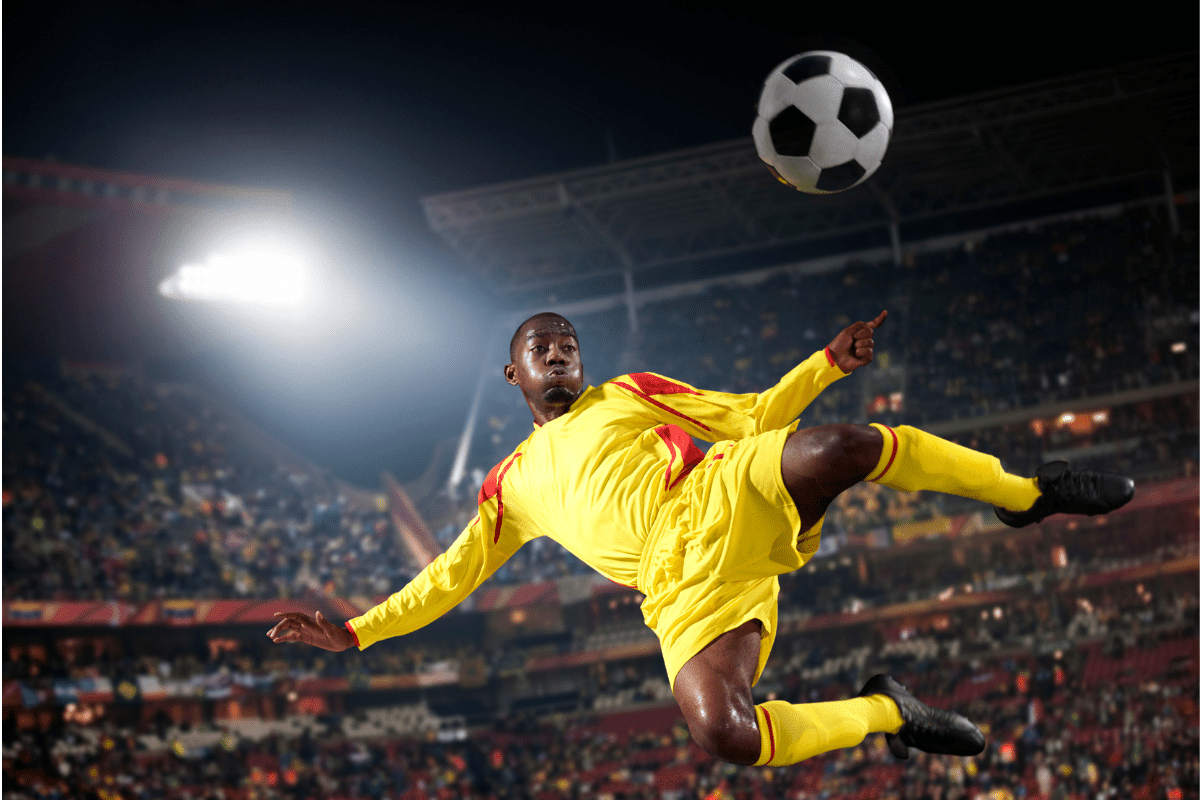Soccer Strength Training: A Complete Guide
I’ve been working as a sports performance coach with college athletes for almost twenty years, both as a Strength and Conditioning Coach and as a Sports Scientist. I’ve also been fortunate over that time to work with some of the best minds in Strength and Conditioning for soccer.
In this Soccer Strength and Conditioning Guide, my goal is to provide you with an outline of everything you should be doing both in the off-season and in-season to maximize your performance on the field.
I’m going to discuss when you should start strength training, how many days per week to train, what exercises to focus on and even how to structure your workouts.
First things first, what’s the best age to start strength training?
When Should I Start Strength Training For Soccer?
There is a long-held myth by many in the general public that lifting weights will stunt your growth. However, study after study and report after report over the years has completely debunked this myth. The Mayo Clinic even recommends that children as young as 7 or 8 can begin strength training.
In my opinion, youth athletes can begin lifting weights once they have the mental maturity and focus needed to strength train safely. For some athletes, this might be 7 or 8 years old. For others, it might be later.
Can the athlete listen and follow directions? Can the athlete stay focused on a single task? Can the athlete stay engaged throughout a training session?
These are the questions that I would have parents ask themselves about their youth athlete(s). If the answers to all 3 are yes, then you could consider strength training. If not, I would suggest waiting a little bit longer.
What Exercises Should a Youth Athlete Begin With?
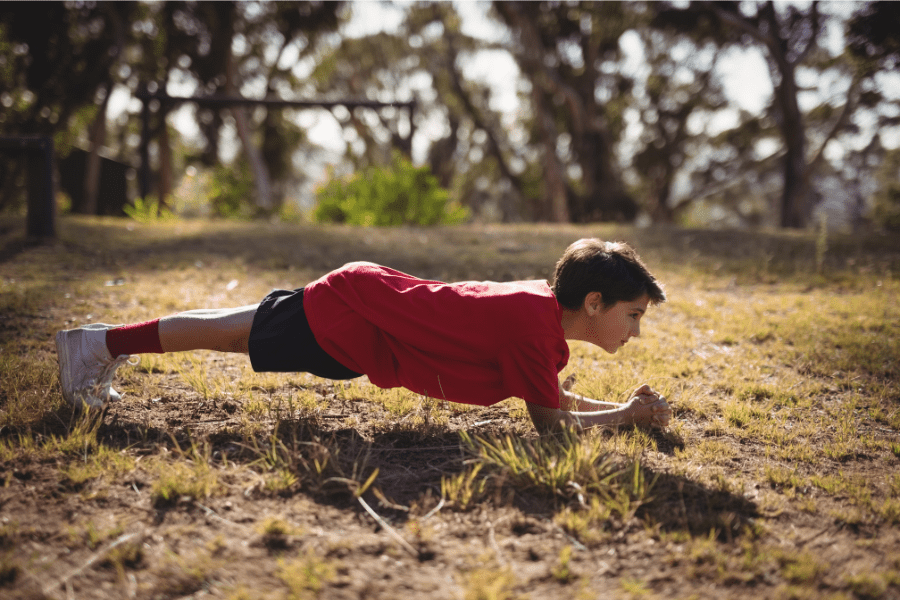
Youth athletes should stick with the basics. Learning proper technique and form should be the only focus at this age. Exercises like Push-Ups, Pull-Ups, Bodyweight Squats, Lunges and Sit-Ups are all strength training exercises that don’t even require a piece of equipment.
Those simple bodyweight movement patterns will translate over to exercises like Goblet Squats and Dumbbell Bench Press when the athlete is ready.
Again, I can’t emphasize this enough. Technique should be the only priority. Strength will come as a natural byproduct at this age. But, the movements they learn at 7 to 10 years old will carry with them for a lifetime.
Once a soccer player reaches high school, we can start to get into more advanced training techniques that I’m going to dive into now.
Off-Season Soccer Strength Training
The tips and advice that I’m going to go through now will apply to most soccer players from high school and even transitioning into college. But, keep in mind there are always exceptions to all rules and situations.
Days Per Week
High school soccer players should be strength training 3 to 4 days per week.
Whether to strength train 3 or 4 days per week really comes down to schedule and personal preferences. One isn’t necessarily “better” than the other.
Personally, I prefer a schedule of lifting 4 days per week, but I know of some very successful college strength programs that lift 3 days per week during certain portions of the off-season and have great success.
The workouts for a 3 day-per-week program tend to be more total body lifts and slightly longer than 4 day-per-week schedules.
Ultimately, you just need to decide which schedule fits your overall schedule better.
Phase I – Early Off-Season/Post Season
What should your soccer strength training program be focusing on? Well, in my opinion, it depends on the time of the year.
The first phase is the first few weeks directly after the season. Players need a couple of weeks either completely off or with minimal work to help recover both mentally and physically from the grueling soccer season.
Active recovery workouts that include activities like foam rolling, stretching, range of motion exercises and pre-hab type movements should be the most prevalent during this time period.
Phase II – Off-Season
When the season wraps up in late fall*, the next soccer season is months away, so conditioning doesn’t need to be a priority at this time. This makes spring a great time to develop strength.
*When your season ends may be different depending on your level/league, but the same overall principles will still apply.
The strength training program should reflect that.
Overall volume (sets and reps) can be higher to help promote strength and hypertrophy. You’re basically building a new foundation for each athlete that they’ll be able to utilize throughout the off-season and going into the next year.
Coach’s Note: Off-season goals will be dependent on the individual and/or team as well. For example, a men’s freshman soccer player who needs to add 10 pounds of muscle and barely squats 100 pounds should have different training priorities than a senior who is at his desired bodyweight and squats 315 pounds. These are just general guidelines.
Phase III – Late Off-Season/Pre-Season
Phase III, or the Pre-Season phase, is typically 6 to 8 weeks from the official start of camp.
Strength training priorities shift as the off-season progresses. Now, with the season getting closer, conditioning will play a larger part in our overall strength and conditioning plan.
In the weight room, the strength training plan will also shift. The strength and hypertrophy focus of the early off-season will shift to a focus on power. The sets of five to ten reps (on the big compound movements) will be few and far between and sets of 3, 2 and even singles will play a much larger role.
In-Season Soccer Strength Training
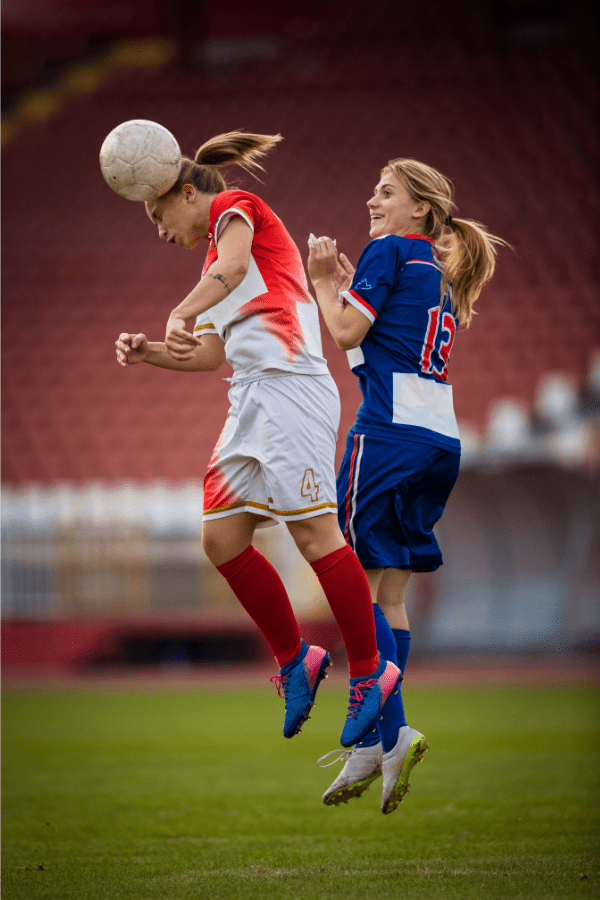
One of the biggest mistakes a soccer player can make is to stop strength training once the season starts. This is due to multiple factors.
First and foremost, reducing your risk of injury is one of the primary benefits of strength training. However, you can start to lose strength after only a couple of weeks of not training. Strength training during the season will keep your strength levels up and lower your risk of injury.
Second, championships are won at the end of the season, not at the beginning. Not strength training during the season means you will be at your weakest of the entire year when it’s time to play for a ring.
Finally, strength training during the season will help you get a jump start on your next off-season. Instead of spending months just getting back the strength you lost, you’ll be able to start making new gains immediately. Over the course of a 4-year career (or longer including high school and college), the difference this can make is staggering.
Days Per Week
How many days a week you should train in-season depends on the game schedule and the amount of playing time you’re getting on gameday.
Schedule
Soccer tends to have a somewhat chaotic and inconsistent schedule. Depending on the level you’re playing, the games per week and the days on which you’re playing can vary – sometimes wildly.
It’s important to look at the schedule and plan out ahead of time when you’re going to workout (and how).
A break in the schedule might mean you can get two or even three days of training in. Playing 3 games in one week? Your workouts might only consist of an active recovery session or two.
Playing Time
If you’re starting or playing significant minutes off the bench, then your priority should obviously be on maximizing your performance each and every game.
However, if you’re not seeing minutes on the field or even redshirting, then I would strongly suggest continuing to emphasize your physical development.
I like to have at least one extra lifting session with this group of players per week so that they can continue to improve even though they’re missing out on those game minutes.
In-Season Priorities
During the season, our strength training priorities shift again. Our time in the weight room is more limited during the season, especially with the players playing significant minutes.
We want to maximize that time with mobility work and knee, ankle and shoulder work to help keep joints healthy and functioning well. But, we will also use that time to continue developing strength. We want to maintain, or even gain, strength during the season.
We do this by lowering the overall volume but maintaining the intensity (percentages used) of what would be typical of the off-season.
So, for example, instead of 5 sets of 5 reps for Back Squat at 75%, we may do 4 sets of 3 reps at 75%. This allows us to keep our strength but reduce the amount of ‘wear and tear’ on the body.
What are the Best Exercises for Soccer Players?

I like to think about exercise selection broken down into four different categories:
- Olympic Lifts for Power Development
- Compound Lifts for Strength Development
- Supplemental Lifts for Hypertrophy
- Core Work for Core Strength and Stability
Now, Olympic Lifts do not work just power development and Compound movements do not just work strength development – it’s simply their main emphasis.
Coach’s Tip: Regardless of how “good” an exercise is, you should only do exercises that you are technically proficient at. This goes for both coaches and players. If you don’t know how to do an exercise, don’t try to coach it and don’t try to do it. There are always alternatives for ANY exercise. There is no need to get yourself hurt trying to do an exercise you don’t know how to do.
Olympic Lifts
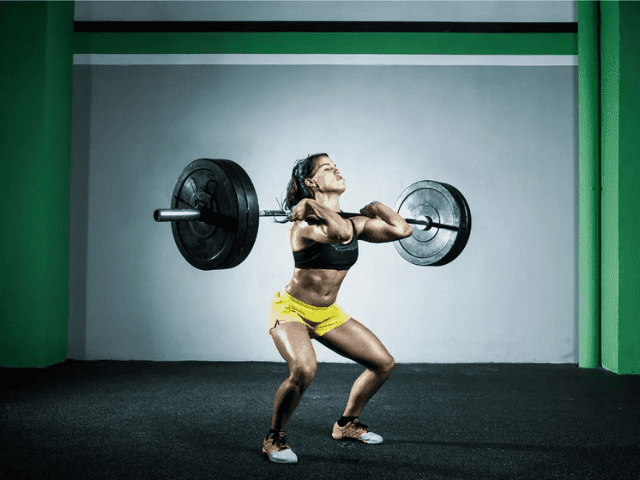
I am a big proponent of the Olympic lifts for soccer players. Olympic Lifts include the lifts themselves and all their variations. Power Clean, Hang Clean, Hang Snatch, Clean Pulls, Push Presses and Power Jerks are just some of the Olympic movements I like to include in my programming.
Each has its own proper teaching progression. I start simple and continue to add more complexity as players progress. This allows us to minimize the amount of time spent coaching and maximizing the amount of time spent training.
For example, when freshmen first arrive on campus, we do not start with a full Clean right away. Instead, we start with a Trap Bar Deadlift and a Front Squat. Those movements lay the foundation for being able to properly setup and pull weight from the floor and receive the bar in a front rack position.
After a few weeks, I’ll introduce a Hang Power Snatch and a Clean Pull. A soccer player in my program won’t do a full Clean (starting from the floor and catching in a full Front Squat) until after a full year in the program.
And, by the way, you can get pretty strong doing exercises like Trap Bar Deadlifts and Front Squats – they’re definitely not just for learning technique. This brings me to the second type of exercise that should be a part of your soccer strength training, Compound Lifts.
Compound Lifts
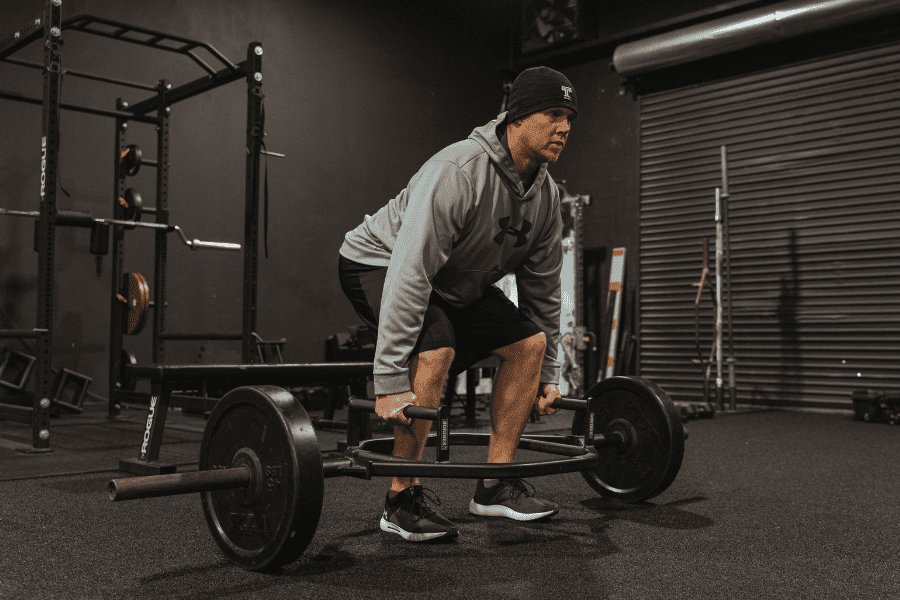
Compound Lifts are exercises that involve multiple joints and multiple muscle groups. These are exercises like Squats, Deadlifts, Pull-Ups and Bench Press.
If you’re serious about developing strength then Compound Lifts should be a staple in your strength training program. However, no different than Olympic Lifts, you should only do exercises that you know how to do correctly. Trying to Deadlift heavy weight with poor technique is a recipe for injury.
Olympic Lifts and Compound Lifts should take up around 80% (or more) of the time spent in the weight room. These are the exercises that are going to give you the most “bang for your buck”. These are also the exercises that look like actual athletic movements that are performed on a soccer field.
If you’re spending most of your time in the weight room over in the dumbbell area doing curls and flexing in the mirror, trust me, you’re getting outworked.
Supplemental Lifts
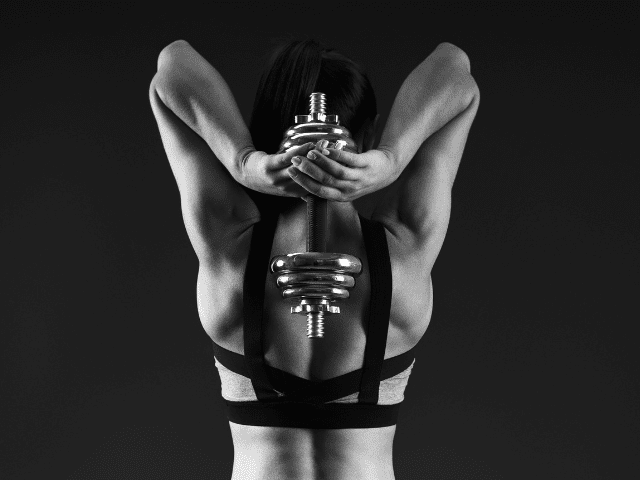
These are your single-joint exercises. Lateral Raises, Dumbbell Curls and Tricep Extensions fall into this category. Don’t get me wrong, some of these exercises are the most fun to do, but they should be exactly what their name says – supplemental.
A few sets of Supplemental Lifts are a good way to help develop extra hypertrophy at the end of a workout.
Core Work

I think this one is pretty self-explanatory. I think (maybe I’m wrong, who knows) all of us know at this point that having a strong core is important.
Just don’t get bogged down doing Crunches every day and checking the box for Core Work. Training your core comes in many different forms.
Weighted exercises like Weighted Sit-ups and Cable Crunches can build strength by adding extra resistance. Exercises like Planks and Stir The Pot will emphasize and improve core stability. Many medicine ball exercises like Side Throws can add rotational core work as well as develop power.
Hopefully, you get the point I’m trying to make. Challenging your core in different ways is vastly superior to laying on your back and doing bodyweight core exercises every day.
What Order Should Exercises Go In?
Properly organizing your workouts is a big component of maximizing the effectiveness of every set and every rep. Exercises should be ordered in pretty much the same order I just put them in – Olympic Lifts, Compound Lifts, Supplemental Lifts and then Core Work.
In general, exercise order should follow two main rules:
- Fast Movements –> Slow Movements
- Multi-Joint Movements –> Single Joint Movements
Explosive exercises should be done toward the beginning of the workout when the body, particularly the CNS (Central Nervous System), is fresh. This will ensure that you get the most out of these power-developing movements.
Doing these types of lifts while fresh will also help to reduce injury. Fatigue can be the enemy of technique, so doing the most technical lifts while freshest only makes sense.
After your power movements should be the Compound Multi-Joint exercises. Exercises like Back Squats and Bench Press need multiple muscle groups firing at full strength to get the most out of each movement. Smoking your triceps at the beginning of a workout will create a weak link in your Bench Press, therefore reducing its effectiveness.
Final Thoughts
Simply showing up in the weight room and working hard will only get you so far. Yes, you’ll be one step ahead of the players who just show up and check a box and two steps ahead of the players who don’t show up at all.
However, to really get an advantage over your top competition, you should be trying to maximize your training every day. Choosing the right days to train, selecting the right exercises with the correct amount of sets and reps and organizing it all together.
If it all seems like a lot to manage, I understand. It’s the same feeling I get when I look under the hood of my car. I know the engine makes the car go, but if you asked me to point out the manifold I’d be in trouble.
My suggestion would be to find a quality strength and conditioning coach and/or program to help guide you through this process.
Finally, if you need a soccer strength and conditioning program, I have one available on my app. It is the same type of program that I use when training soccer athletes myself.

